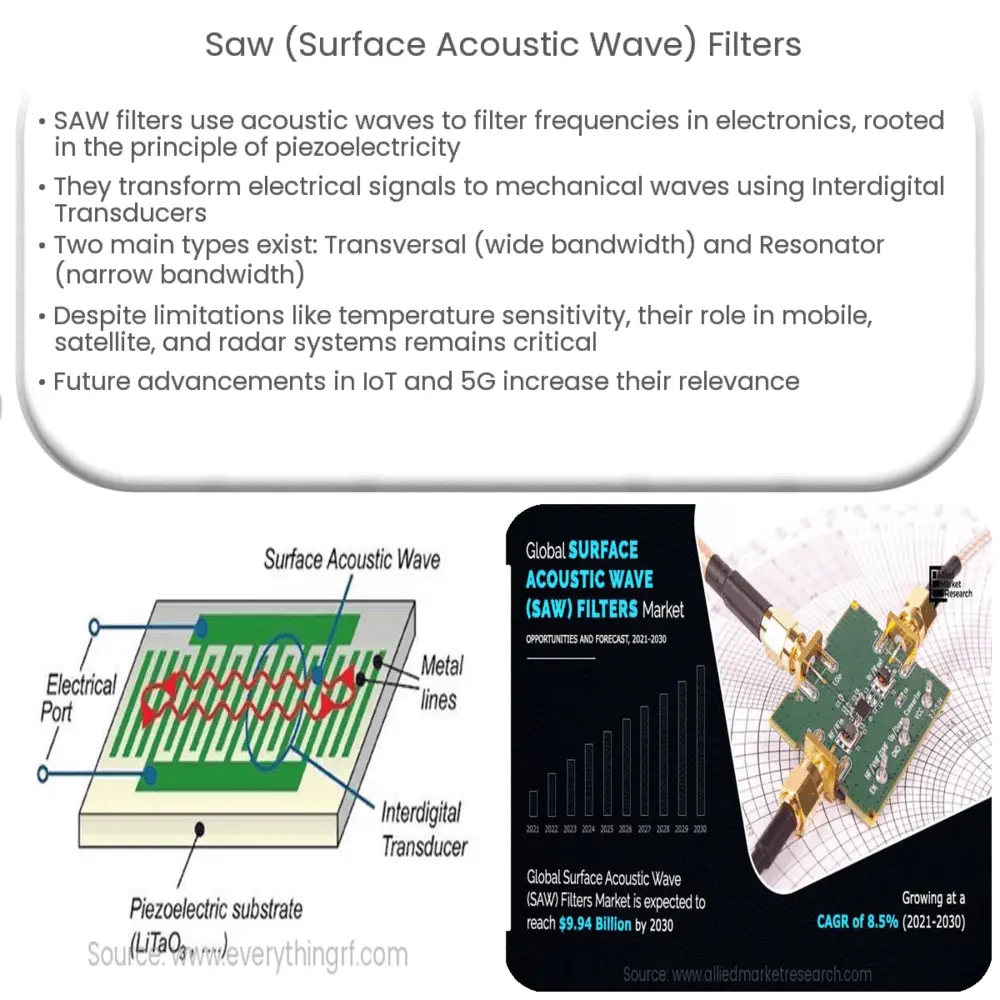Explore the world of Surface Acoustic Wave (SAW) filters, their working principle, types, applications, and future trends.

Introduction to SAW Filters
Surface Acoustic Wave (SAW) filters are a type of electronic filter that uses acoustic waves to filter frequency in electronic devices. Designed on the principles of piezoelectricity, they have become an essential component in the field of telecommunications and signal processing.
Principle of Operation
At the heart of a SAW filter lies the principle of piezoelectricity, a phenomenon where certain materials generate an electric charge in response to mechanical stress. In SAW filters, this mechanical stress is introduced in the form of surface acoustic waves.
- Transmitter: The journey of the signal begins at the Interdigital Transducers (IDTs), which serve as the transmitter. The IDTs convert the electrical signal into a mechanical wave.
- Medium: The generated wave then travels across the surface of the piezoelectric substrate, which serves as the medium.
- Receiver: Upon reaching the receiving IDTs, the mechanical wave is converted back into an electrical signal, thus completing the process.
Types of SAW Filters
Based on their construction and application, SAW filters can be broadly divided into two categories:
- Transversal SAW Filters: These are the simplest form of SAW filters where the IDTs are arranged in a parallel manner on the piezoelectric substrate. This type of filter is best suited for applications requiring a wide bandwidth and moderate filter characteristics.
- Resonator SAW Filters: These are a more advanced type of SAW filter where the IDTs are placed inside a reflector array to form a resonator. Resonator SAW filters are used for applications requiring narrow bandwidth and sharp filter characteristics.
SAW filters offer a range of advantages including small size, light weight, low cost, and excellent performance at high frequencies. This makes them ideal for various applications such as mobile communication, satellite communication, and radar systems.
Applications of SAW Filters
In the modern world, SAW filters find applications in a variety of areas:
- Mobile Communication: SAW filters are vital in mobile communication systems, where they are used to filter out unwanted frequencies and to separate signals in different frequency bands.
- Satellite Communication: In satellite communication systems, SAW filters are used to filter and process signals before they are transmitted or after they are received.
- Radar Systems: SAW filters are used in radar systems to improve signal resolution and to reduce signal interference.
The Future of SAW Filters
With the advent of the Internet of Things (IoT) and 5G technology, the demand for high-performance electronic devices is on the rise. As such, the need for SAW filters, which offer excellent performance in high-frequency applications, is expected to grow exponentially. Future advancements in the design and manufacture of SAW filters promise to make them even more efficient and versatile, thus broadening their applicability in various fields.
Challenges and Limitations
Despite their many advantages, SAW filters also have some limitations. For instance, they are sensitive to temperature changes and physical stress, which can affect their performance. Additionally, their operation is limited to a certain frequency range. Efforts are ongoing to overcome these limitations and to enhance the overall performance of SAW filters.
Conclusion
In conclusion, Surface Acoustic Wave (SAW) filters, with their unique ability to filter high-frequency signals, have become an indispensable component in the realm of electronic devices. From mobile and satellite communication to radar systems, their contribution is significant. Despite some challenges, ongoing technological advancements promise to improve their performance and expand their applicability, ensuring that SAW filters will continue to play a crucial role in the electronic and communication industries.



